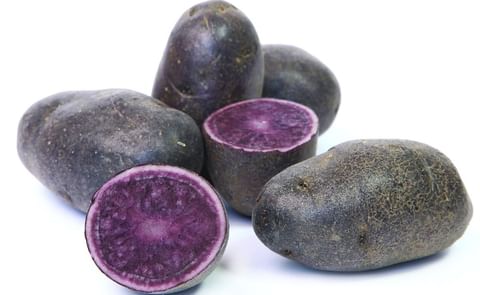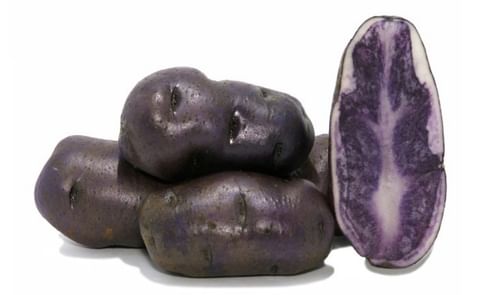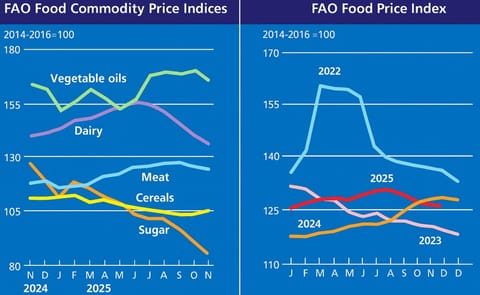Purple Power: 7 Benefits of Purple Potatoes
Purple Power: 7 Benefits of Purple Potatoes
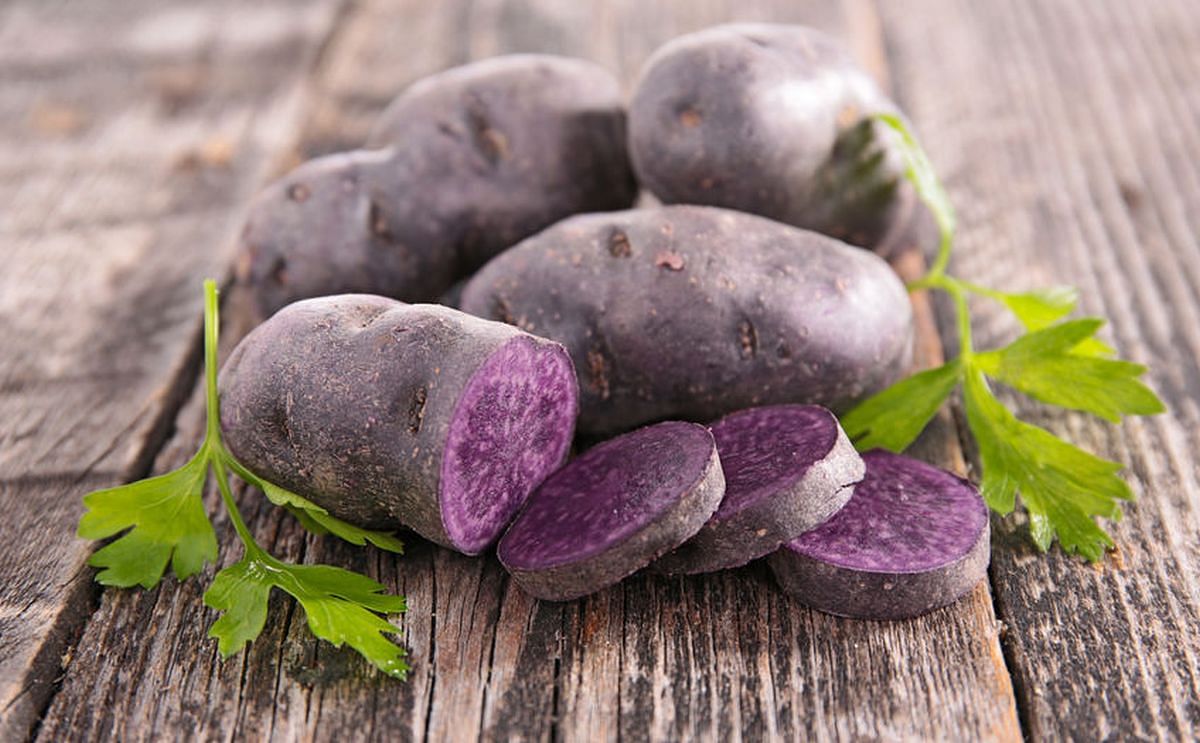
Purple potatoes are the eye-catching gems of the potato aisle. Like other members of the potato family (Solanum tuberosum), they come from a tuber plant native to the Andes mountain region in South America.
They have a blue-purple to almost black outer skin and an inner flesh that’s brilliant purple, even after cooking. Some common varieties include Purple Peruvian, Purple Majesty, All Blue, Congo, Adirondack Blue, Purple Fiesta, and Vitelotte.
They have a denser texture and slightly nuttier, earthier flavor than white potatoes. Purple potatoes are a tasty way to add a pop of color to your plate while enjoying a serving of health benefits.
Here are 7 surprising benefits of purple potatoes.
1. Highly nutritious
Potatoes often get a bad rap because of their high starch content, but they contain many other important nutrients and can be a very healthy addition to your diet (1).
Purple potatoes have a nutrient content similar to that of other varieties of potatoes in the Solanum tuberosum family, though their mineral content can vary depending on the soil in which they were grown (1, 2, 3).
There is a misconception that all of the nutrients in potatoes are found in their skin. In fact, more than half of their nutrients are found in their flesh (3).
A 3.5-ounce (100-gram) serving of cooked potato with the skin provides (4):
- Calories: 87
- Protein: 2 grams
- Carbs: 20 grams
- Fiber: 3.3 grams
- Fat: less than 1 gram
- Manganese: 6% of the Daily Value (DV)
- Copper: 21% of the DV
- Iron: 2% of the DV
- Potassium: 8% of the DV
- Vitamin B6: 18% of the DV
- Vitamin C:14% of the DV
- Interestingly, potatoes have more potassium than bananas. In addition, a serving of potatoes provides 3 grams of fiber, from both the flesh and skin, and they’re naturally low in sodium (3, 4).
SUMMARY
All potatoes, including purple potatoes, are quite nutritious and provide a range of nutrients in both their skin and flesh. They’re especially rich in minerals and boast more potassium than a banana.
2. Better for blood sugar
The glycemic index (GI) is a measure of the extent to which a food raises your blood sugar. It ranges from 0 to 100, and a GI greater than 70 is considered high.
A comparison study in humans found that purple potatoes have a GI of 77, yellow potatoes have a GI of 81, and white potatoes have a GI of 93 (5).
While all potato varieties impact blood sugar levels because of their carbohydrate content, purple potatoes may exert less of an effect than other types due to their high concentration of polyphenol plant compounds.
These compounds may decrease the absorption of starches in the intestines, therefore minimizing purple potato’s impact on blood sugar levels (5).
An animal study observed similar results, finding that feeding purple potato extract to rats resulted in better glucose tolerance and improved short and long-term blood sugar levels (6).
SUMMARY
Eating purple potatoes instead of white potatoes is a good move when watching your blood sugar. While the starch in purple potatoes increases blood sugar, it does so to less of an extent than the starch in yellow or white varieties.
3. Packed with antioxidants

Antioxidants are plant compounds that can protect your cells from the damaging effects of oxidative stress. (Courtesy: Foodnetwork)
Like other colorful fruits and vegetables, purple potatoes’ bright color is a telltale sign that they’re high in antioxidants. In fact, they have two to three times more antioxidant activity than white or yellow potatoes (7).
Purple potatoes are especially rich in polyphenol antioxidants called anthocyanins. They’re the same type of antioxidant found in blueberries and blackberries (3, 7, 8).
A higher anthocyanin intake is linked to several benefits, including healthier cholesterol levels, improved vision and eye health, and a reduced risk of heart disease, certain cancers, and diabetes (7, 8).
In addition to their high anthocyanin content, purple potatoes pack other antioxidants common to all types of potatoes, including (9):
- vitamin C
- carotenoid compounds
- selenium
- tyrosine
- polyphenolic compounds like caffeic acid, scopolin, chlorogenic acid, and ferulic acid
A small study in eight people found that loading up on one meal of whole purple potatoes increased their blood and urine antioxidant levels. In contrast, eating a similar amount of refined potato starch in the form of biscuits caused a decrease (9).
Another study in men who ate 5.3 ounces (150 grams) of different colored potatoes each day for 6 weeks observed that the purple potato group had lower levels of inflammatory markers and markers of DNA damage, compared with the white potato group (10).
SUMMARY
Eating purple potatoes can boost your antioxidant intake and reduce inflammation. They’re especially rich in anthocyanins, which are antioxidant compounds linked to improved eye and heart health, as well as a lower risk of chronic disease.
4. May improve your blood pressure
Eating purple potatoes may promote blood vessel and blood pressure health. This may partly be due to their higher potassium content, as this nutrient helps reduce blood pressure, but their antioxidant content likely plays a role, too.
A small 4-week study in people with high blood pressure found that eating six to eight purple potatoes twice daily reduced systolic and diastolic blood pressure (the top and bottom numbers of a reading) by 3.5% and 4.3%, respectively (9).
In addition, some studies suggest that compared with eating white potatoes, eating purple potatoes may reduce arterial stiffness. Having stiff arteries increases your risk of heart attack or stroke, as your vessels can’t dilate as easily in response to changes in blood pressure (11).
In general, eating more polyphenol-rich foods, including those that contain anthocyanins like purple potatoes, may help relax and strengthen your blood vessels.
In fact, the polyphenol compounds in purple potatoes and many other foods work to reduce blood pressure in a way similar to that of some types of blood-pressure-lowering medications known as angiotensin-converting-enzyme (ACE) inhibitors (12).
SUMMARY
Purple potatoes have been found to improve blood pressure. This effect might be related to their polyphenolic antioxidant compounds, which work in a way similar to that of some blood-pressure-lowering medications.
5. May reduce your risk of cancer
A few lab studies have indicated that some of the compounds in purple potatoes, including their antioxidants, may help prevent or fight cancer, including colon and breast cancer (13,14).
In one study, cancer cells that were treated with purple potato extract grew more slowly. In some cases, the extract even caused cancer cell death (13,14).
It’s important to note that the research thus far has been limited to cancer cells treated in a lab and cancers in lab rats. Therefore, it’s unknown whether eating purple potatoes would have similar effects in humans.
SUMMARY
Some of the compounds in purple potatoes may slow the growth of — or even kill — certain cancer cells. The current research is limited to lab studies, so it’s unknown whether adding purple potatoes to your diet affects cancer risk.
6. Can help fill your fiber gap
Most people don’t meet the Dietary Guidelines for Americans’ recommendation to consume 14 grams of fiber per 1,000 calories, but adding a few servings of purple potatoes to your diet each week can help fill the gap (15).
Dietary fiber helps keep you feeling full, prevents constipation, stabilizes blood sugar, and helps maintain healthy cholesterol levels.
The fiber content of potatoes varies slightly depending on the cooking method, but mostly depending on whether you eat the skin.
For example, a 3.5-ounce (100-gram) potato with the skin cooked in the microwave contains 3.3 grams of fiber, while a potato of the same size boiled without the skin has 1.8 grams (16).
Part of the starch in purple (and all) potatoes is a type of fiber called resistant starch. Resistant starch resists digestion in your gastrointestinal tract, but the bacteria in your large intestine ferment it (3).
During this fermentation process, compounds known as short-chain fatty acids are produced. These compounds contribute to improved gut health.
The resistant starch content of potatoes also varies depending on the cooking method, though it doesn’t seem to vary much between the color of potatoes. Resistant starch is highest when potatoes are cooked and then chilled, but not reheated (3).
SUMMARY
Adding purple potatoes to your diet can help increase your fiber intake and add some gut-healthy resistant starch to your diet. To reap the greatest fiber benefits, eat them with the skin on and cook them ahead of time, eating them chilled, such as in a salad.
7. Brighten up your plate
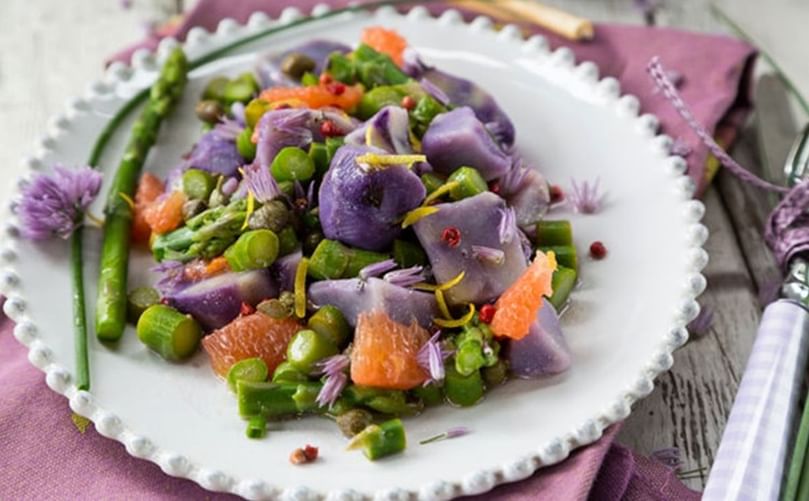
Substituting them for a lighter flesh potato is a great way to add more color and interest to your meals — after all, you really do eat with your eyes. (Courtesy: Skinnyms)
You can use purple potatoes similarly to how you’d use white, yellow, or red varieties.
Use them to make mashed or baked potatoes and add your favorite toppings for a side dish that everyone will want to try.
If you like them crispy like fries, slice them into wedges, toss them with olive oil, minced garlic, and rosemary, and roast them at 400°F (204°C) for about 20 minutes or until they’re tender. To reap the benefit of their resistant starch, use purple potatoes to make potato salad.
Leave the skins on, cut them into chunks, and boil them until they’re tender. Then drain and toss them with thinly sliced onions, a handful of fresh minced herbs, and some Dijon-vinaigrette dressing. Chill them in the refrigerator and serve them cold.
SUMMARY
Boil, mash, or roast purple potatoes just like you would any other light-fleshed variety. They don’t take any additional time to cook and add interest and a bright pop of color to your meals.
The bottom line
Purple potatoes are a healthy and colorful member of the potato family that’s worth getting to know. You can prepare them similarly to how you would prepare white or yellow flesh potatoes, but if you swap them in, you’ll enjoy quite a few health benefits.
Compared with regular potatoes, they have a lower glycemic index and may be better for your blood sugar.
Many of their health benefits, including those related to blood pressure and cancer protection, stem from their content of anthocyanins — important antioxidants that are abundant in these colorful potatoes.
Next time you head to the supermarket, see if you can find this unique potato variety and give it a go.


